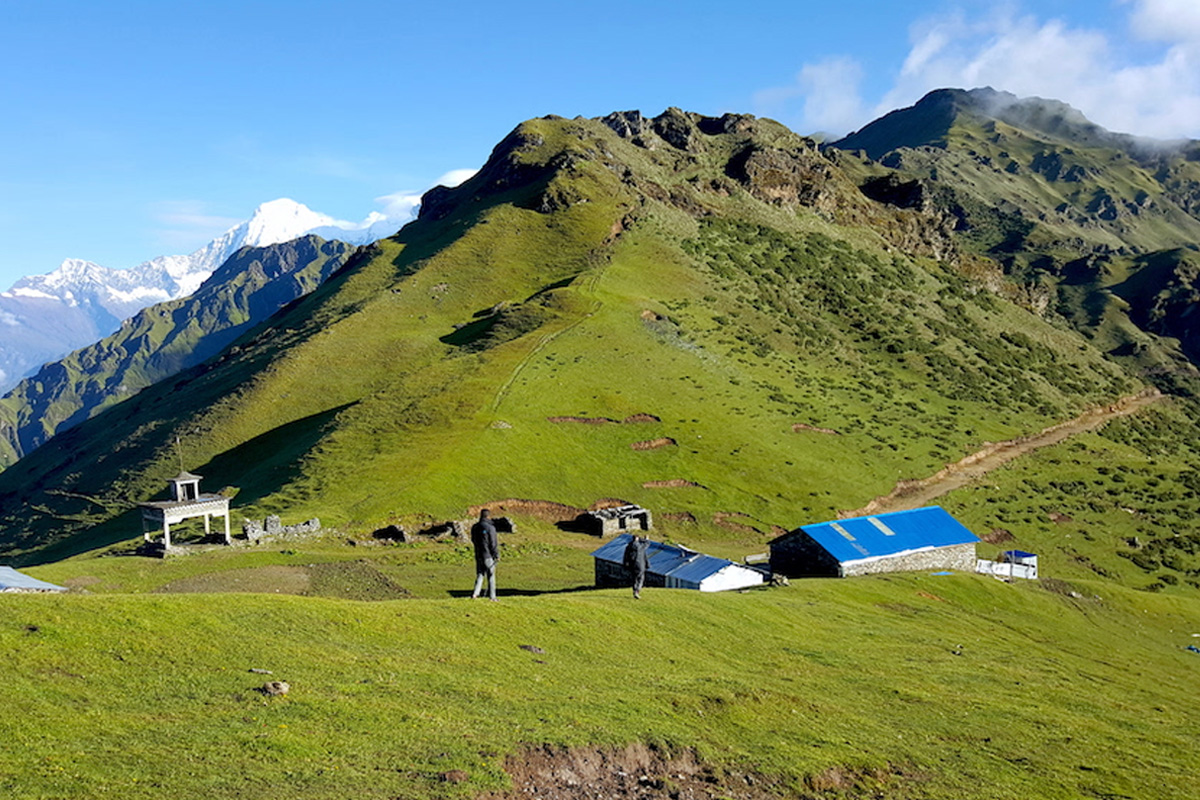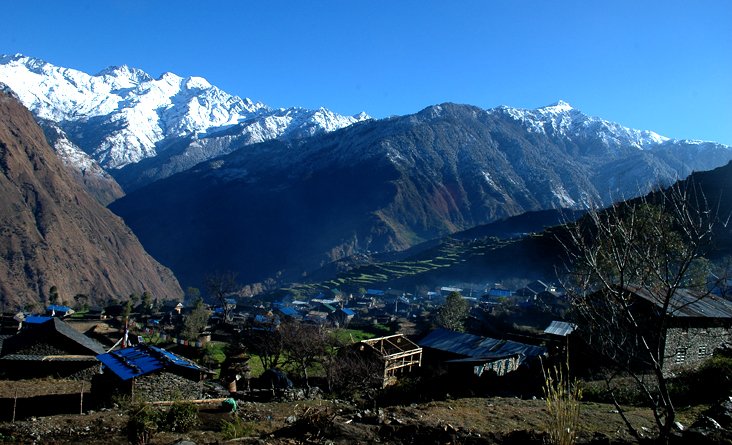Trip Overview

The Ruby Valley Trek is located in the northern part of Nepal, in the Ganesh Himal region. The trek offers stunning views of the Ganesh Himal range, Langtang Himal, Manaslu, and Annapurna.
Highlights:
-
Scenic Beauty: The trek is known for its breathtaking landscapes, diverse flora and fauna, and pristine natural beauty. The route takes trekkers through lush forests, terraced fields, and traditional villages.https://highpasstreks.com/
-
Cultural Experience: Trekkers have the opportunity to interact with the local communities and experience the unique culture of the region. The trek passes through several ethnic villages, providing insights into the lifestyle, traditions, and hospitality of the people.
-
Gosaikunda Lake: Some variations of the Ruby Valley Trek may include a visit to Gosaikunda Lake, a sacred alpine lake nestled in the Langtang National Park. The lake holds religious significance for Hindus, and the area is surrounded by beautiful mountain scenery.
-
Ganesh Himal Range: The trek offers stunning views of the Ganesh Himal range, providing trekkers with a less crowded and serene trekking experience compared to some of the more popular routes in Nepal.https://highpasstreks.com/
Trekking Duration and Difficulty: The duration of the Ruby Valley Trek can vary depending on the specific itinerary chosen, but it is generally considered a moderate trek in terms of difficulty. Trekkers should be prepared for varying trail conditions, including steep ascents and descents.
Permits: As with most trekking routes in Nepal, it’s essential to obtain the necessary permits before embarking on the Ruby Valley Trek. Check with local authorities or trekking agencies for the most up-to-date permit requirements.
Access: The trek typically starts and ends in the village of Syabrubesi, which is accessible by road from Kathmandu. The trailhead is in the Ganesh Himal region, and the trek takes you through diverse landscapes and picturesque villages.https://highpasstreks.com/
Difficulty Level: Moderate
The Ruby Valley Trek is classified as moderate in difficulty, making it accessible to trekkers with a reasonable level of fitness. While prior trekking experience is beneficial, it’s not mandatory. The trek involves daily walks of 5–7 hours across varied terrains, including forested paths, terraced fields, and rocky trails. The ascent to Pangsang La Pass is the most challenging segment, requiring stamina and determination.
🏞️ Terrain & Trail Conditions
Trekkers will navigate through a mix of terrains:
-
Forested Areas: Lush rhododendron and pine forests.
-
Agricultural Lands: Terraced farmlands showcasing local agriculture.
-
Mountain Passes: Steep ascents and descents, particularly near Pangsang La Pass.https://highpasstreks.com/
While the trails are less crowded than popular routes like Everest or Annapurna, they are well-defined but can be rugged and uneven in sections.
🏡 Accommodation & Amenities
Given the remoteness of the region, accommodations are primarily homestays and basic teahouses. These offer a unique opportunity to experience local hospitality and culture. However, amenities are limited, so trekkers should be prepared for basic facilities and consider carrying essential supplies.https://highpasstreks.com/
🕰️ Best Time to Trek
The optimal seasons for the Ruby Valley Trek are:
Trekking during the monsoon season (June–August) is less advisable due to slippery trails and leeches.
🧳 Preparation Tips
-
Physical Fitness: Engage in regular cardio and strength training exercises leading up to the trek.
-
Gear: Invest in sturdy trekking boots, weather-appropriate clothing, and a reliable backpack.
-
Health Precautions: Carry a first aid kit, water purification tablets, and any necessary medications.
-
Guidance: Hiring a local guide can enhance the experience and ensure safety.https://highpasstreks.com/
Detail Itinerary
Day 1: Kathmandu to Syabrubesi (1,460m)
- Drive from Kathmandu to Syabrubesi (Approx. 7-8 hours)
- Overnight in Syabrubesi
Day 2: Syabrubesi to Gatlang (2,200m)
- Trek from Syabrubesi to Gatlang
- Explore Gatlang village
- Overnight in Gatlang
Day 3: Gatlang to Somdang (3,270m)
- Trek from Gatlang to Somdang
- En route, enjoy the scenic beauty and cultural experiences
- Overnight in Somdang
Day 4: Somdang to Pangsang Pass Base Camp (3,842m)
- Trek from Somdang to Pangsang Pass Base Camp
- Enjoy panoramic views of the Ganesh Himal range
- Overnight at Pangsang Pass Base Camp
Day 5: Pangsang Pass Base Camp to Tipling (1,975m)
- Trek from Pangsang Pass Base Camp to Tipling
- Descend through diverse landscapes
- Overnight in Tipling
Day 6: Tipling to Chalish (1,738m)
- Trek from Tipling to Chalish
- Scenic landscapes and cultural encounters
- Overnight in Chalish
Day 7: Chalish to Hindung (2,128m)
- Trek from Chalish to Hindung
- Experience the diversity of the trail
- Overnight in Hindung
Day 8: Hindung to Thulo Chaur (1,745m)
- Trek from Hindung to Thulo Chaur
- Enjoy the natural beauty of the surroundings
- Overnight in Thulo Chaur
Day 9: Thulo Chaur to Briddim (2,345m)
- Trek from Thulo Chaur to Briddim
- Explore Briddim village and its cultural attractions
- Overnight in Briddim
Day 10: Briddim to Syabrubesi (1,460m)
- Trek from Briddim to Syabrubesi
- Final day of trekking
- Overnight in Syabrubesi
Day 11: Syabrubesi to Kathmandu
- Drive from Syabrubesi to Kathmandu
- Return to Kathmandu and relax
- End of the trek
Trip Includes
-
Trekking Permits:
- TIMS (Trekkers’ Information Management System) card
- Other necessary permits for the trek, such as National Park or Conservation Area entry permits
-
Transportation:
- Transportation from Kathmandu to the trek starting point (usually Syabrubesi) and back to Kathmandu at the end of the trek
-
Accommodation:
- Accommodation in teahouses or lodges along the trekking route
- Accommodation in Kathmandu before and after the trek
-
Meals:
- Meals during the trek (breakfast, lunch, and dinner)
- Teahouse meals typically include local and international dishes
-
Professional Guide and Porter:
- Experienced and licensed trekking guide
- Porter services to carry a portion of the trekker’s load (often a specific weight limit per trekker)
-
Equipment:
- Trekking equipment such as tents, sleeping bags, and mattresses if camping is involved
- Duffel bag for trekkers to pack their belongings
-
Insurance:
- Insurance for trekking staff, including guides and porters
-
Emergency Support:
- Emergency evacuation arrangements in case of serious illness or injury
-
Orientation and Briefing:
- Pre-trek orientation and briefing in Kathmandu
-
Sightseeing in Kathmandu:
- Guided sightseeing tours in Kathmandu to explore cultural and historical landmarks
-
Airport Transfers:
- Airport transfers in Kathmandu
Trip Excludes
-
International Flights:
- The cost of flights to and from your home country to Kathmandu is usually not included in the trekking package.
-
Personal Expenses:
- Expenses such as personal snacks, beverages (other than those provided during meals), phone calls, internet usage, laundry, and any personal purchases are usually not included.
-
Travel Insurance:
- Trekking agencies often require trekkers to have their own travel insurance that covers emergency evacuation, medical expenses, and other potential risks during the trek.
-
Meals in Kathmandu:
- Meals in Kathmandu before and after the trek are typically not included in the package.
-
Alcoholic Beverages:
- Alcoholic drinks are generally not included in the trekking package and need to be paid for separately.
-
Tips and Gratuities:
- Tips for guides, porters, and other trekking staff are usually not included. Tipping is a customary practice in the trekking industry, and trekkers may choose to tip based on their satisfaction with the services.
-
Additional Accommodations:
- Accommodations in Kathmandu beyond what is provided as part of the standard package are typically not included.
-
Optional Activities:
- Any optional activities, such as side trips, cultural events, or excursions not specified in the standard itinerary, are usually not included.
-
Excess Baggage Fees:
- Fees for excess baggage, either on international flights or during the trek, are generally not covered by the trekking package.
-
Personal Gear:
- Personal trekking gear, including clothing, footwear, and other personal items, is the responsibility of the trekker.












